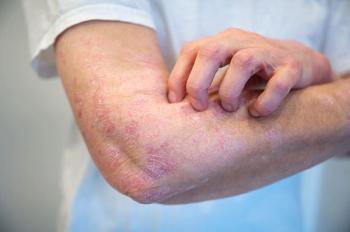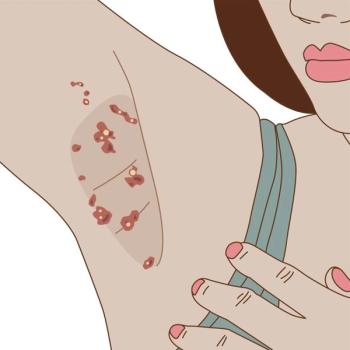
Air-Filled Foreign Body in Lower Abdominal and Pelvic Regions and Chondrodermatitis Nodularis Chronica Helicis
A 56-year-old man presented tothe emergency department with ahistory of constipation, abdominalpain, and blood-stained mucusdrainage from the rectum. The patienthad no fever; vital signs werestable. A vague fullness was felt in thelower abdomen. Rectal examinationrevealed anal warts; a patulous analsphincter; and a smooth, mobile, firmmass above the dentate line.
1. Constipation, pain, andblood-stained rectal drainage
A 56-year-old man presented tothe emergency department with ahistory of constipation, abdominalpain, and blood-stained mucusdrainage from the rectum. The patienthad no fever; vital signs werestable. A vague fullness was felt in thelower abdomen. Rectal examinationrevealed anal warts; a patulous analsphincter; and a smooth, mobile, firmmass above the dentate line.
Abdominal films showed asmoothly marginated, cylindricaltubular filling defect that projected towardthe lower abdominal and pelvicregions, with the long axis in a craniocaudalorientation.
What are you looking at here?
1. Constipation, pain, and bloodstainedrectal drainage: Upon furtherquestioning, the patient stated that hehad inserted a shampoo bottle intothe rectum to relieve constipation.The x-ray image was compatible withan air-filled foreign body as describedby the patient. There was no evidenceof pneumoperitoneum.
Because of the large amount ofmucus, the bottle could not be manuallyextracted. The patient was givena general anesthetic, suprapubic pressurewas applied, and the bottle wasremoved using a surgical instrument.Findings of a postprocedure sigmoidoscopywere normal, except for mucosaledema.
The patient was observed for24 hours; he was discharged fromthe hospital after a psychologicalevaluation.
2. Sores on ears
A 46-year-old man was concernedthat the tender "sores" on hisears were cancer. The patient, whowas paralyzed from the neck down,used headphones to listen to music.
At first glance, the lesions-nearlyidentical bilateral crusted papuleson the lower antihelix--looked likebasal cell carcinomas.
Is this cancer, or does the historysuggest another diagnosis?
2. Sores on ears: The patient oftenlistened to music while trying tofall asleep. Because he was unableto remove the headphones, he worethem throughout the night. Thisraised the suspicion that the lesionswere chondrodermatitis nodularischronica helicis, which may havebeen caused by pressure on the antihelixcartilage. A biopsy confirmedthe diagnosis.
In men, these lesions usuallydevelop on the helix; the antihelix isthe more common site in women.Intralesional corticosteroidscleared this condition. The patientwas advised to avoid wearing headphonesand to try using small earpiecesinstead.
3. Right forearm numbness
A 30-year-old heavy equipment operator awoke on a Sunday morning with numbness of theright forearm; he also was unable to lift his fingers from a flexed position or pick up objects. He reportedthat he had slept with his right arm tucked under his body.
The patient had no history of numbness. He denied pain, allergies, general malaise, bowel orbladder changes, or other new symptoms. Moderate degenerative joint disease of the cervical regionwas noted.
The patient had been in a single-vehicle accident 7 months earlier. At the time, radiographsshowed no overt signs of trauma. The patient was treated by a chiropractor for whiplash syndromeand released from care 4 weeks after the accident. On further investigation, it was learned that the patienthad been arrested twice for driving under the influence.
What is the likely cause of this patient's prolonged forearm numbness?
3. Right forearm numbness: Physical examination demonstrated no muscleatrophy, 2+ deep tendon reflexes, and no sensory deficits. Upper extremitystrength was rated 5/5, except for the extensor surface of the right forearm,which was 0/5. The patient was unable to straighten his right wrist from aflexed position. All the extensor muscles were grossly evaluated.
A complete blood cell count was normal, except for a mildly elevatedeosinophil level. The comprehensive metabolic panel, serum lead level, andthyroid hormone levels were normal. An MRI scan of the cervical regiondemonstrated mild to moderate degenerative joint disease and posterior diskbulges at C4/5 and C7/T1, with no signs of foraminal encroachment.
An electromyogram of the right arm showed an inability to obtain activerecruitment in any of the radial nerve-innervated muscles; however, there wasno abnormal spontaneous activity in the other right forearm muscles.
The probable diagnosis is early acute right radial neuropathy/conductionblock neuropraxia above the level of the elbow, most likely in the mid humeruslevel of the radial groove. This presents as "Saturday night palsy" or "honeymoonpalsy" secondary to abnormal pressure in the radial groove area. Thiscondition is seen in intoxicated persons (or honeymooners) who fall asleep inan awkward position.1 The patient also had mild sensory polyneuropathy; noevidence of cervical radiculopathy was detected.
Treatment included bracing to avoid excessive compression of the medianand ulnar nerves, electrical stimulation to avoid atrophy of the extensormuscles, and focused occupational therapy for the hand. Counseling for alcoholabuse was recommended.
Follow up patients with Saturday night palsy 2 to 3 months after treatmentis begun. The prognosis for a complete recovery is good.
REFERENCE:1. Kelly WN. Textbook of Internal Medicine. 3rd ed. Philadelphia: Lippincott-Raven; 1997:2409.
4. Thinning hair in a young girl
Several months earlier, the mother of an 8-year-old girl had first noticedthe loss of hair on the crown of her daughter's scalp. The child was otherwisehealthy and complained of no problems.
The affected area of the patient's scalp was not completely devoid of hair;the ends of the remaining hairs were broken off at varying lengths.
What clues help you narrow the differential and identify the cause of thispatient's hair loss?
4. Thinning hair in a young girl: Unlike conditions such as alopecia areata inwhich hairs are not firmly retained by the scalp, this patient's remaining hairscould not be pulled out easily because the follicles were essentially healthy. Redness,scaling, scarring, and edema of the scalp are features of tinea capitis, lichenplanopilaris, sarcoid and discoid lupus, and other causes of hair loss, but usuallyare absent in trichotillomania, or compulsive hair pulling, and were not seen inthis patient. Trichotillomania, which most commonly affects the frontal-parietalscalp-an area that can be easily reached by the patient-was diagnosed. Otherparts of the scalp and the eyelashes also can be involved.
Patients who consciously pull hair from their scalp usually are manifestingsymptoms of obsessive-compulsive disorder, anxiety, or other less seriouspsychopathology. Psychotherapy and/or psychotropic agents are warrantedfor these patients.
The patient's motivational level and the disease's severity influence thechoice of treatment. Simply coating the hair with petroleum jelly to make it moredifficult to grasp and gently but persistently admonishing the patient can be effective.Other patients require more complex therapies that include psychotropicdrugs and counseling.
Newsletter
Enhance your clinical practice with the Patient Care newsletter, offering the latest evidence-based guidelines, diagnostic insights, and treatment strategies for primary care physicians.
























































































































































































































































































